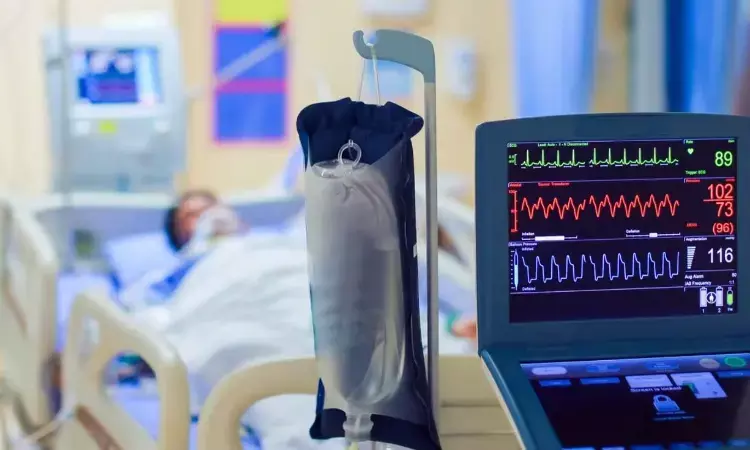- Home
- Medical news & Guidelines
- Anesthesiology
- Cardiology and CTVS
- Critical Care
- Dentistry
- Dermatology
- Diabetes and Endocrinology
- ENT
- Gastroenterology
- Medicine
- Nephrology
- Neurology
- Obstretics-Gynaecology
- Oncology
- Ophthalmology
- Orthopaedics
- Pediatrics-Neonatology
- Psychiatry
- Pulmonology
- Radiology
- Surgery
- Urology
- Laboratory Medicine
- Diet
- Nursing
- Paramedical
- Physiotherapy
- Health news
- Fact Check
- Bone Health Fact Check
- Brain Health Fact Check
- Cancer Related Fact Check
- Child Care Fact Check
- Dental and oral health fact check
- Diabetes and metabolic health fact check
- Diet and Nutrition Fact Check
- Eye and ENT Care Fact Check
- Fitness fact check
- Gut health fact check
- Heart health fact check
- Kidney health fact check
- Medical education fact check
- Men's health fact check
- Respiratory fact check
- Skin and hair care fact check
- Vaccine and Immunization fact check
- Women's health fact check
- AYUSH
- State News
- Andaman and Nicobar Islands
- Andhra Pradesh
- Arunachal Pradesh
- Assam
- Bihar
- Chandigarh
- Chattisgarh
- Dadra and Nagar Haveli
- Daman and Diu
- Delhi
- Goa
- Gujarat
- Haryana
- Himachal Pradesh
- Jammu & Kashmir
- Jharkhand
- Karnataka
- Kerala
- Ladakh
- Lakshadweep
- Madhya Pradesh
- Maharashtra
- Manipur
- Meghalaya
- Mizoram
- Nagaland
- Odisha
- Puducherry
- Punjab
- Rajasthan
- Sikkim
- Tamil Nadu
- Telangana
- Tripura
- Uttar Pradesh
- Uttrakhand
- West Bengal
- Medical Education
- Industry
In-plane supraclavicular subclavian vein catheterization effective and safe option in critical patients

Tunisia: According to a study published in Annals of Intensive Care, the in-plane supraclavicular subclavian vein technique offers an efficient and secure substitute for the traditional ultrasound-guided out-of-plane internal jugular vein catheterization in critically ill adult patients.
With two main venous pathways, the internal jugular vein (IJV) and subclavian vein, the central venous catheter (CVC) installation is one of the most often performed invasive operations for the management of critically ill patients. The use of US-guidance for IJV cannulation is currently well-established, and the majority of studies have combined an out-of-plane (OOP) needle approach with a short-axis view.
According to the authors, there haven't been any published studies that contrast adult cannulations using the short-axis OOP-IJV and long-axis IP supraclavicular SCV (IP-SSCV).
In order to implant US-guided CVCs in adult intensive care units, this study compared the efficiency and safety of OOP-IJV and IP-SSCV methods.
For this objective, one of two cannulation techniques-ultrasound-guided OOP-IJV or IP-SSCV-was randomly assigned to a group of 250 patients who needed central venous catheterization in quick succession. Three physicians performed all catheterizations. The success rate on the first try was the main result. Additionally recorded were the lengths of time required for ultrasound scanning, venous punctures, insertions, total access, puncture attempts, needle redirections, success rate, guidewire progressing issues, venous collapse, and adverse events.
Key conclusive points:
- In the IP-SSCV group (83.2%) compared to the OOP-IJV group (63.2%), the first attempt success rate was considerably greater (p = 0.001).
- Longer ultrasonic scanning time (16.54 ± 13.51 vs. 5.26 ± 4.05 s; p <0.001) and shorter insertion time (43.98 ± 26.77 vs. 53.12 ± 40.21 s; p = 0.038) were both shown to be related with the IP-SSCV group.
- fewer puncture attempts (1.16± 0.39 vs. 1.47 ± 0.71; p <0.001), needle redirections (0.69± 0.58 vs. 1.17 ± 0.95; p <0.001), guidewire advancement issues (2.4% vs. 27.4%; p < 0.001), venous collapse (2.4% vs. 18.4%; p < 0.001), and adverse events (8.8%vs. 13.6%; p = 0.22) were observed.
"The IP-SSCV cannulation is a safe and effective technique for performing and teaching CVC insertion in adult intensive care units,, with a higher first attempt success rate, a lower rate of difficulties with guidewire insertion, and a lower incidence of hematoma at the puncture site than with the OOP-IJV cannulation," asserted the authors.
The IP-SSCV strategy offers a promising alternate technique for central venous catheterization, according to the authors' analysis. For its routine usage in daily practice, more clinical research is required.
REFERENCE
Trabelsi, B., Hajjej, Z., Drira, D. et al. Comparison of ultrasound-guided internal jugular vein and supraclavicular subclavian vein catheterization in critically ill patients: a prospective, randomized clinical trial. Ann. Intensive Care 12, 91 (2022). https://doi.org/10.1186/s13613-022-01065-x
Dr Kamal Kant Kohli-MBBS, DTCD- a chest specialist with more than 30 years of practice and a flair for writing clinical articles, Dr Kamal Kant Kohli joined Medical Dialogues as a Chief Editor of Medical News. Besides writing articles, as an editor, he proofreads and verifies all the medical content published on Medical Dialogues including those coming from journals, studies,medical conferences,guidelines etc. Email: drkohli@medicaldialogues.in. Contact no. 011-43720751


